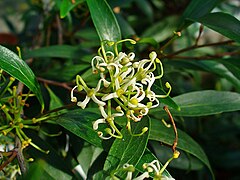| Habit | tree
| |
|---|---|---|
| Height: | ⇕ | 100 ft"ft" can not be assigned to a declared number type with value 100. |
| Width: | ⇔ | 10 ft"ft" can not be assigned to a declared number type with value 10. to 15 ft"ft" can not be assigned to a declared number type with value 15. |
| Lifespan: | ⌛ | perennial |
| Bloom: | ❀ | early spring, mid spring, late spring, early summer, mid summer, late summer |
| Exposure: | ☼ | sun |
|---|---|---|
| Features: | ✓ | flowers |
| USDA Zones: | 9 to 12 | |
| Flower features: | ❀ | white |
|
salignus > |
Stenocarpus salignus, known as the Scrub Beefwood is an Australian rainforest tree in the Proteaceae family. Found in warmer rainforests on the coast and ranges. It is often found in warm temperate rainforest on poorer sedimentary soils, or on volcanic soils above 750 metres (2500 ft) above sea level. It was originally described by the botanist Robert Brown in 1810.
Stenocarpus salignus is noticeable for the tessellated bark and the sparse foliage high in the canopy. The range of natural distribution is from Kioloa (35° S) near Batemans Bay in south coastal New South Wales, to Rockhampton, Queensland (23° S) in tropical Queensland.
The scrub beefwood is a shrub or small tree, occasionally up to 30 metres (100 ft) tall and 60 cm (24 in) in trunk diameter. The trunk is often irregular and buttressed with dark brown scaly bark.
The leaves are wavy edged, with between one and three main longitudinal veins. Leaves are alternate, simple entire, ovate to lanceolate or elliptic. Leaves have a noticeable hard point, and at the other end they gradually taper to the base. Glossy dark green above, and paler below; 8 to 15 cm (3-6 in) long, 3 to 5 cm (1-2 in) wide. There is considerable variation in leaves of this species.
In October to January (North or South of the equator? convert to season), white fragrant flowers form in umbels, similar to the flowers of the related Grevillea. This is followed by the development of the seed pods which are narrow follicles, 5 to 10 cm long, green initially and maturing to a brown colour. Inside are many thin papery oblong shaped seeds around 12 mm long. Fruit matures from March to June. Fresh seeds germinate rapidly, cuttings also strike well.
This species is sometimes seen in specialist native nurseries in Eastern Australia; it grows well in part shade on well drained mildly acidic soils. it is less commonly grown than its better known relative S. sinuatus.
Read about Stenocarpus salignus in the Standard Cyclopedia of Horticulture
|
|---|
|
Stenocarpus salignus, R. Br. Moderate-sized tree, glabrous or the infl. minutely pubescent: lvs. 2-4 in. long, in the typical form ovate-lanceolate or elliptical, acute, acuminate or rarely obtuse, tapering to a short petiole: peduncles slender, bearing an umbel of 10-20 fls., occasionally up to 30 fls.: fls. greenish white; perianth usually less than 1/2 in. long; ovary slightly silky-pubescent or nearly glabrous. Austral.—Cult. in Calif. CH
|
Cultivation
Propagation
Pests and diseases
Varieties
Gallery
References
External links
- w:Stenocarpus salignus. Some of the material on this page may be from Wikipedia, under the Creative Commons license.
- Stenocarpus salignus QR Code (Size 50, 100, 200, 500)
